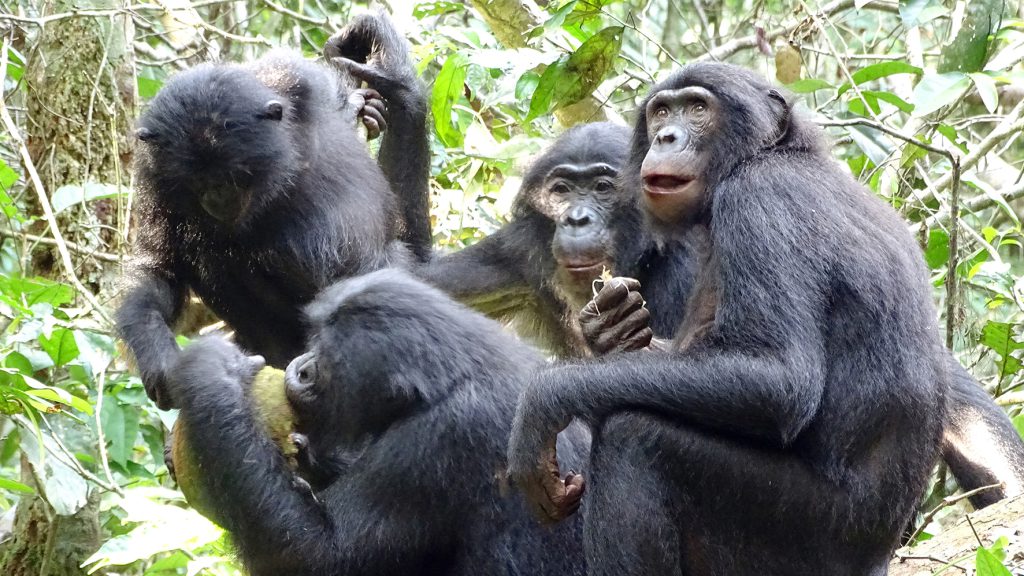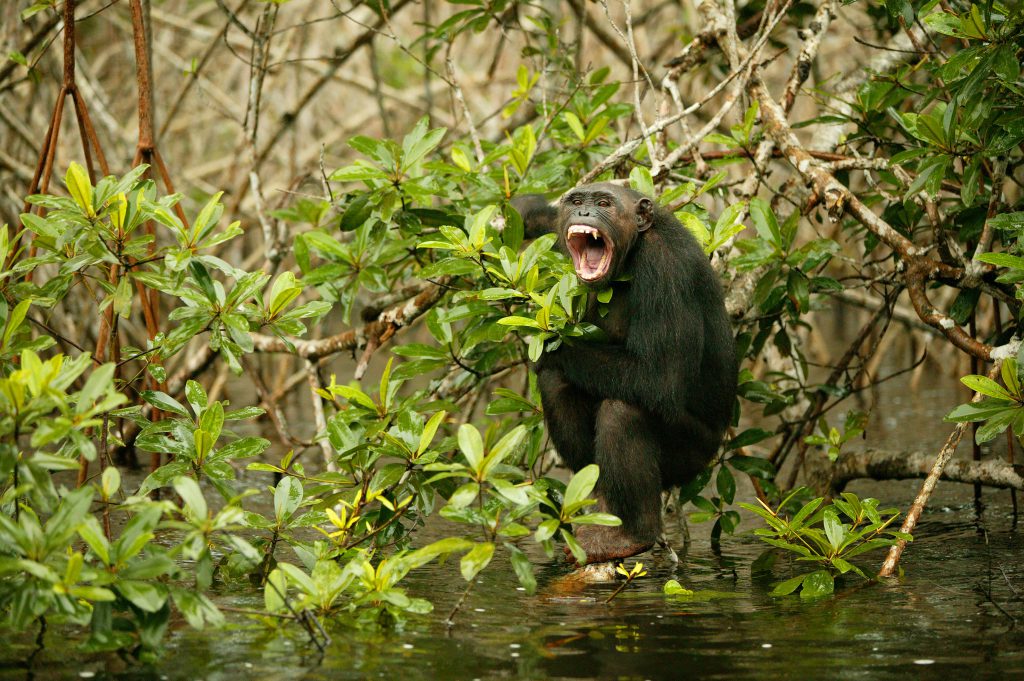Bonobos Spied Sharing a Feast

People are weird—at least compared to other animals—in our willingness to share our meals not only with friends and family but even with strangers. Now bonobos in the wild have been spotted doing much the same: giving tasty meat morsels to those outside their own social group.
Anthropologists interested in the evolution of social behavior often turn to our closest relations—chimpanzees and bonobos—to shed light on what life was like for our last common ancestor about 6–7 million years ago. Food sharing in particular is an interesting practice to monitor, as it says a great deal about group politics, altruism, and social tolerance.
It is sometimes said that sharing food with strangers is a uniquely human trait that evolved as hominins learned to hunt large prey and benefited from sharing the spoils. But both chimps and bonobos hunt too, and share their meals within their communities. Now researchers report the first observation of food sharing from one community of wild bonobos to another.
“It’s not something that happens often, but it’s possible—that’s amazing,” says Barbara Fruth, who studies primate behavior and is affiliated with Liverpool John Moores University in the U.K. Fruth co-authored the new article in Human Nature with primatologist Gottfried Hohmann of the Max Planck Institute for Evolutionary Anthropology in Leipzig, Germany.
“One of the most important things underscored by this finding is the importance of studying both bonobos and chimps to understand our common ancestor,” says Christopher Krupenye, an evolutionary anthropologist at the University of St Andrews in Fife, U.K., who studies the social intelligence of apes but wasn’t involved with the new work. Traits and behaviors we share with those two species today probably trace back to our common roots, he explains. “Probably our common ancestor had some level of food sharing.”
Chimpanzees and bonobos share about 99 percent of their genome with each other and with humans, though our behaviors are very different. Chimps are known for being very aggressive: They patrol their community boundaries and sometimes fight to the death. But chimps still sometimes share their hunted meat within their group in order to make friends or sexual partners.
Bonobos are often called lovers not fighters, with more open social behaviors compared to other primates: They are well-known for frequent sexual couplings, even between strangers from different communities. “They’re notorious for using sex to build relationships and ease tension,” says Krupenye. And they share their meals of fruit and meat. In one study, captive bonobos would release another bonobo from a locked room in order to share food rather than eat alone; in another experiment with sanctuary animals, bonobos were found to actually prefer sharing with strangers than with family or friends, presumably so as to broaden their social group.
The new observation bumps the evidence for wild bonobo sharing and cross-community spirit up a notch. “There’s never been, to my knowledge, evidence of food sharing between different communities, which is a stronger incidence of helping,” says Krupenye.
The new behavior was spotted in January 2017 when some of Fruth’s colleagues were following two communities of bonobos on either side of a river in the Democratic Republic of the Congo. These communities, containing 30 or 40 bonobos each and living in territories spanning about 60 kilometers, only ran into each other once or twice a year, making them at most distant acquaintances. “Really they are strangers,” says Fruth. Usually when the two groups met at the border of a food patch there was screaming and chasing, Fruth says, though they would sometimes then end up sharing the space.
One day, Camillo, the alpha male from the western community, killed a small antelope, called a duiker, for a meal. Over the next half-hour, females from both communities patiently and demurely asked for a helping by peering at him and stretching out their hands; all the females from his own community, plus a female named Agbaya from the other community, got some of the food. Later, Agbaya took the kill’s head and shared the meat with females from both sides of the river. “They grabbed the duiker and shared it. That’s really extraordinary,” says Fruth.
“It’s a surprising phenomenon in general to document at all; it’s quite striking that any animal would do this,” agrees Krupenye. “But based on what we know about bonobos, it is in line with what you might expect.” As is usual for bonobos, two of the animals (a male from the eastern community and a female from the western one) also coupled up for sex over the course of the meal.
Such communal feasting is perhaps not all that different from the behavior of modern humans, who use food sharing as a way to ease relationships. “You invite your guests from other countries for a meal. This is diplomacy. This is normal for us,” says Fruth. “It must have its roots in our last common ancestor.”
Correction, August 19, 2020
The statement about chimpanzee aggression has been edited to reflect how often chimps fight to the death; researchers do not all agree on why such behavior occurs or how widespread it is.

































